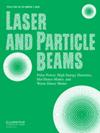Numerical Studies on Bow Waves in Intense Laser-Plasma Interaction
IF 1.9
4区 物理与天体物理
Q4 PHYSICS, APPLIED
引用次数: 1
Abstract
Laser-driven wakefield acceleration (LWFA) has attracted lots of attention in recent years. However, few writers have been able to make systematic research into the bow waves generated along with the wake waves. Research about the bow waves will help to improve the understanding about the motion of the electrons near the wake waves. In addition, the relativistic energetic electron density peaks have great potential in electron acceleration and reflecting flying mirrors. In this paper, the bow waves generated in laser-plasma interactions as well as the effects of different laser and plasma parameters are investigated. Multidimensional particle-in-cell simulations are made to present the wake waves and bow waves by showing the electron density and momentum distribution as well as the electric field along x and y directions. The evolution of the bow wave structure is investigated by measuring the open angle between the bow wave and the wake wave cavity. The angle as well as the peak electron density and transverse momentum is demonstrated with respect to different laser intensities, spot sizes, plasma densities, and preplasma lengths. The density peak emits high-order harmonics up to 150 orders and can be a new kind of “flying mirror” to generate higher order harmonics. The study on the bow waves is important for further investigation on the electron motion around the wake waves, generation of dense electron beams, generation of high-order harmonics, and other research and applications based on the bow waves.强激光等离子体相互作用中弓形波的数值研究
近年来,激光驱动尾流场加速(LWFA)引起了广泛的关注。然而,很少有作者能够系统地研究伴随尾流产生的弓形波。对弓形波的研究将有助于提高对尾迹波附近电子运动的认识。此外,相对论性高能电子密度峰在电子加速和反射飞镜方面具有很大的潜力。本文研究了激光与等离子体相互作用产生的弓形波,以及不同激光和等离子体参数对弓形波的影响。通过对电子密度、动量分布以及x、y方向上的电场分布的模拟,对尾流波和弓形波进行了多维粒子模拟。通过测量船首波与尾流腔之间的开角来研究船首波结构的演化。在不同的激光强度、光斑大小、等离子体密度和预等离子体长度的影响下,证明了角度、峰值电子密度和横向动量的变化。密度峰发出高达150次的高次谐波,可以作为一种新型的“飞镜”来产生高次谐波。弓形波的研究对于进一步研究电子绕尾流运动、密集电子束的产生、高次谐波的产生以及其他基于弓形波的研究和应用具有重要意义。
本文章由计算机程序翻译,如有差异,请以英文原文为准。
求助全文
约1分钟内获得全文
求助全文
来源期刊

Laser and Particle Beams
PHYSICS, APPLIED-
CiteScore
1.90
自引率
11.10%
发文量
25
审稿时长
1 months
期刊介绍:
Laser and Particle Beams is an international journal which deals with basic physics issues of intense laser and particle beams, and the interaction of these beams with matter. Research on pulse power technology associated with beam generation is also of strong interest. Subjects covered include the physics of high energy densities; non-LTE phenomena; hot dense matter and related atomic, plasma and hydrodynamic physics and astrophysics; intense sources of coherent radiation; high current particle accelerators; beam-wave interaction; and pulsed power technology.
 求助内容:
求助内容: 应助结果提醒方式:
应助结果提醒方式:


